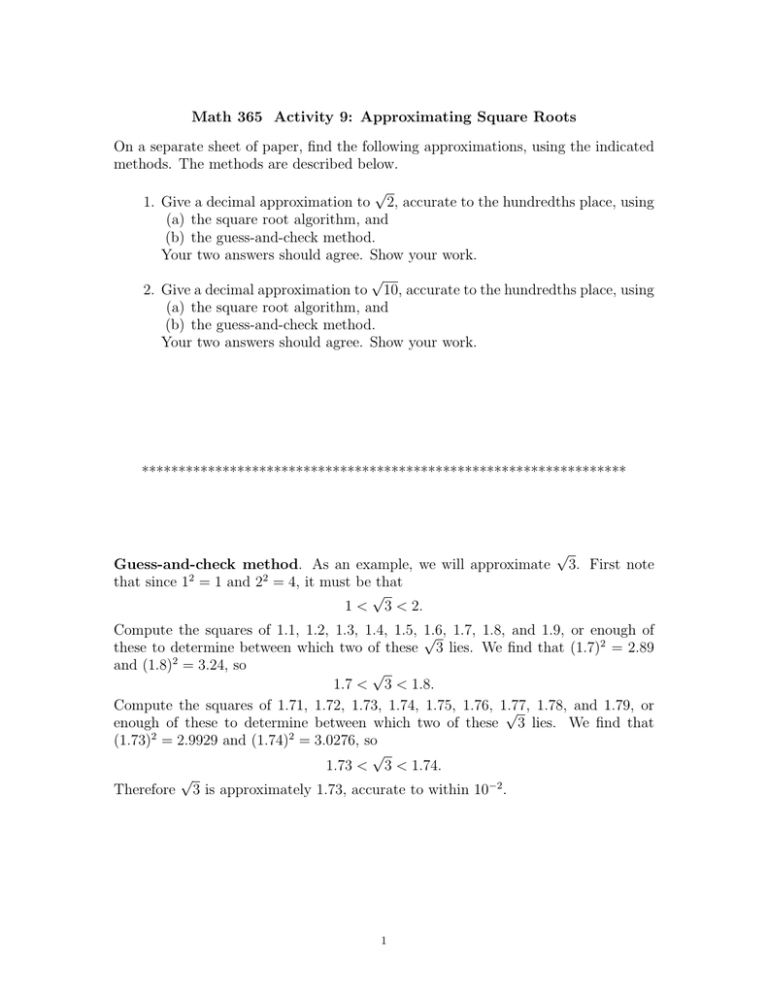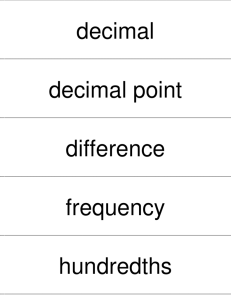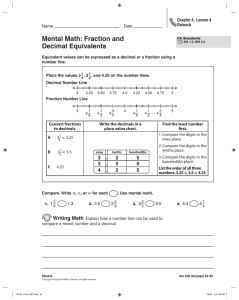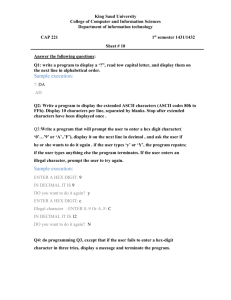Math 365 Activity 9: Approximating Square Roots
advertisement

Math 365 Activity 9: Approximating Square Roots On a separate sheet of paper, find the following approximations, using the indicated methods. The methods are described below. √ 1. Give a decimal approximation to 2, accurate to the hundredths place, using (a) the square root algorithm, and (b) the guess-and-check method. Your two answers should agree. Show your work. √ 2. Give a decimal approximation to 10, accurate to the hundredths place, using (a) the square root algorithm, and (b) the guess-and-check method. Your two answers should agree. Show your work. ****************************************************************** Guess-and-check method. As an example, we will approximate that since 12 = 1 and 22 = 4, it must be that √ 1 < 3 < 2. √ 3. First note Compute the squares of 1.1, 1.2, 1.3, 1.4, 1.5, √ 1.6, 1.7, 1.8, and 1.9, or enough of these to determine between which two of these 3 lies. We find that (1.7)2 = 2.89 and (1.8)2 = 3.24, so √ 1.7 < 3 < 1.8. Compute the squares of 1.71, 1.72, 1.73, 1.74, 1.75, 1.76, 1.77, √ 1.78, and 1.79, or enough of these to determine between which two of these 3 lies. We find that (1.73)2 = 2.9929 and (1.74)2 = 3.0276, so √ 1.73 < 3 < 1.74. √ Therefore 3 is approximately 1.73, accurate to within 10−2 . 1 2 Square root algorithm. This √ is similar to the long division algorithm in some ways. As an example, to find 3, first write 3 under the square root symbol, with zeros after the decimal point grouped in pairs: √ 3. 00 00 (For larger numbers, the digits to the left of the decimal point will also be grouped in pairs.) Now write, just above the square root symbol, aligned with the digit 3, the largest digit whose square is less than or equal to 3 (so this would be 1). Square this number (i.e. square 1), then subtract from 3, similarly to the long division algorithm, but bring down the next two digits: √1 3. 00 00 1 2 00 Next, double the number written on top (the 1 in this case). Write it to the left of the “2 00”, and leave a blank: √1 3. 00 00 1 (2 ) 2 00 Fill in the blank with the largest digit x so that (20+x)x is less than 200, the number to its right. (The number 20 + x will be in parentheses in the display, after you fill in the blank.) In this case, x = 7, since (20 + 7)(7) = (27)(7) = 189. Write the 7 above as well as in the blank, and write the product, 189, below the 200, and subtract: √1 3. 1 (2 7) 2 1 7 00 00 00 89 11 Now bring down the next two digits. Double the number written on top (the 17), write it to the left of the “11 00”, and continue as before; (343)(3) = 1029, so 3 is the correct next digit: √1 7 3 3. 00 00 1 (2 7) 2 00 1 89 (34 3) 11 00 We could continue in the same If we stop here, √ way to get a better approximation. −2 we have an approximation to 3, accurate to within 10 , and it is 1.73.





